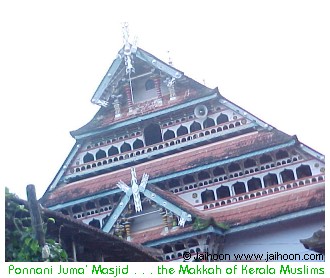The name Ponnani
According to some historical records, Ponnani’s history dates back to 2000 years. There are differences of opinion regarding the evolution of the name of Ponnani.
Legend has it that the Ponnana (meaning a type of elephant in Malayalam) was auctioned in the Brahmin temples here and thus came to be known as Ponnani. Yet another legend says that a king called ‘Ponnan’ ruled the land and was thereafter called Ponnani. 
Historical records rather points to another truth- the use of Gold coins (Ponnanni – pronounced as in money) became widespread and thus Ponnanni later came to be called Ponnani.
Ponnani – the Makkah of Kerala Muslims. The capital of Muslim culture and learning. This is where the Bharat river, Arabian Sea and Veliyankode river meets.
Ponnani, often referred as the cultural capital of Kerala Muslims, has some of the most rare collection of Arabic books of the past. There are about 50 madrassas around Ponnani. The Thottungal Masjid built by Sheikh Faridudhin, is the oldest mosque in Ponnani. It is around 300 years old.
Ponnani was considered the Al Azhar university of Kerala, for its great religious schools and teachers. Ponnani was called the small Makkah in Kerala, Tamil Nadu, Malaya, Indonesia, Lakshadeep etc. It was the scholars of the Makhdum family that gave Ponnani this historic importance. They had migrated from Yemen centuries ago.
William Logon on Ponnani
William Logon, the historian, records in his Malabar manual about the Ponnani Juma’ Masjid built in 925 Hijrah is 90 ft long and 60 ft wide.
Zainudhin Ibn Ali Ibn Ahmed Ma’bari was the one who built it. He was the Makhdum, meaning the one who was worthy of service. He held the reigns of spiritual leadership of Muslims in and around Ponnani. He authored many books of which some of are textbooks in Egyptian and other Arab countries’ universities.
William Logon says that in 1887 there were 400 students in the Juma’ Masjid Madrasa.
Kunhai Musliyar the philosophical poet, Umar Qazi – the Sufi and freedom fighter, Sheikh Syed Hasan Jifri the renowned scholar who fought the British, Ali Musliyar who was martyred in 1921 while fighting the British – were some of the products of Ponnani Madrasa of Juma’ Masjid.
Ponnani according to Buchanan
… I then entered Ponnani where I had to cross a river just after leaving Veliyankode. This river, which flows into the sea, is very wide. It is very convenient to carry goods via this river. Animals usually cross this river by swimming. The boat carriers found here are the most compact and attractive among other carriers found elsewhere in Malabar.
Ponnani is the abode of Thangal – the religious head of Mappilas. He belongs to the ancestry of Prophet’s daughter. The Thangal and his nephew are of handsome figure. Their character is different from other religious heads. The Thangal is a man of great humility. He showed great respect towards me. He invited me to have a meal with him. This is unusual practice among Indians.
The Thangal told me that the Muslims in Malabar are called Mappilas and those in Tamil Nadu are called Labba. But he made it clear that more than anything else, they liked to be addressed as Muslims.
Because of their Arabian ancestry, the Muslims here are more clan-conscious than the tartar Muslims of north India. Islam had spread across India along with settlements of Arabs and they had mixed with the natives. But there still remains some families who maintain their ancestry afresh without mixing with the natives. They are using a special script (perhaps Arabi Malayalam).
Note: After the martyrdom of Tipu Sultan in Fourth Mysore War in 1799, the English East India Company appointed several officers to prepare detailed report on the newly conquered lands. Francis Buchanan was one of them. The report was published in book form entitled – A journey through the countries of Mysore, Canara and Malabar.
Features of Early Muslims in Kerala
The early Muslims of Kerala built mosques which was predominantly wooden and had no imposing minarets.
Their chief source of livelihood was agriculture. Trade was also popular towards the coastal areas.
The rulers were Hindus and Muslims were subjects.
The Muslims enjoyed respect in the society. The King looked upon them as ‘harbingers of prosperity’.
The slaves would gain freedom once they embraced Islam.
Almost all the Muslims follow the Shafi’te school of Muslim Jurisprudence (This holds true even today despite the presence of other schools of thought).
The Ponnani Script
The Arabic language is a gallery of various beautiful forms. The exploration of the rigid, scientific and most splendid writing patterns has required the constant study and hardworking of skilled scholars belonging to different periods.
Arabic is the oldest language. It was the language of Adam (as). History reveals that Adam has written on clay bricks. In the beginning, there were no dots or Harkats (symbol for pronunciation) for Arabic letters in the beginning phase of Islam. Due to this, it became rather difficult for those who had been entering Islam at a faster pace, for Quran recitation and hence occurrence of frequent mistakes created a problem. The Muslim leadership gave a serious thought on this issue and thereafter Caliph Ali appointed Abul Aswad for finding a solution to this problem.
Improvement in writing pattern
Abul Aswad, who thought intensely about the problem, began improvement by giving harkat to the Arabic writing system. This harkat was given only for the final alphabets of words. This improvement was introduced by giving each dot after a letter denoting fatah, a dot below for kisr, and a dot front of the word (at left) for dhama’. These dots were double if they were tanveen. Abul Aswad himself completed these symbols after the death of Caliph Ali, i.e., during the reign of Muawiyya.
Developments in harkat continued to take place with the passage of time. Instead of putting harkat for the final letter, harkat was introduced for all letters. According to this improvement, changes were introduced in the pattern of harkat. Letters became harkat instead of dots. Historical evidence has found the man responsible for this in Khaleef ibn Ahmed al Faraheedi.
In the following years and in various phases, progress in writing styles continued to take place in different parts of the world. Suloosi, Farisi, Nasqi, deewani, kufi, Ruke’e, Ijazah were some of the forms developed then.
The Ponnani flavor for Arabic Writing
A new calligraphic form for Arabic was born in Kerala also. Such a style – beauty conscious, simple and noble (all of which are characteristic of Keralites) was the Qathu Funani or the Ponnani script. It was born at the cradle of scholarship and learning fondly referred to as the Minor Makkah. The Ponnani script is the most recent form of Arabic writing form.
Even in the matter of shape of alphabets, the Ponnani script has got many special characteristics. This script can accommodate more dots. The letters, which narrow down to the end, are very thick which is helpful in distinguishing them apart from the harkat. Perhaps that is why Ponnani script is insisted upon for writing Arabi-Malayalam.
Summarized from an essay ‘Ponnani script- An Introduction’ by KK Abdullah Maulavi

2 comments
prayer is power
I dont know why you mentioned thangals as religious head of mappilahs. may be a section among mappilahs has approved that but dont generalize.